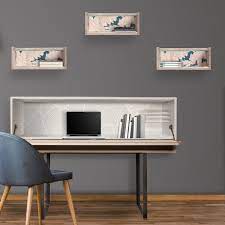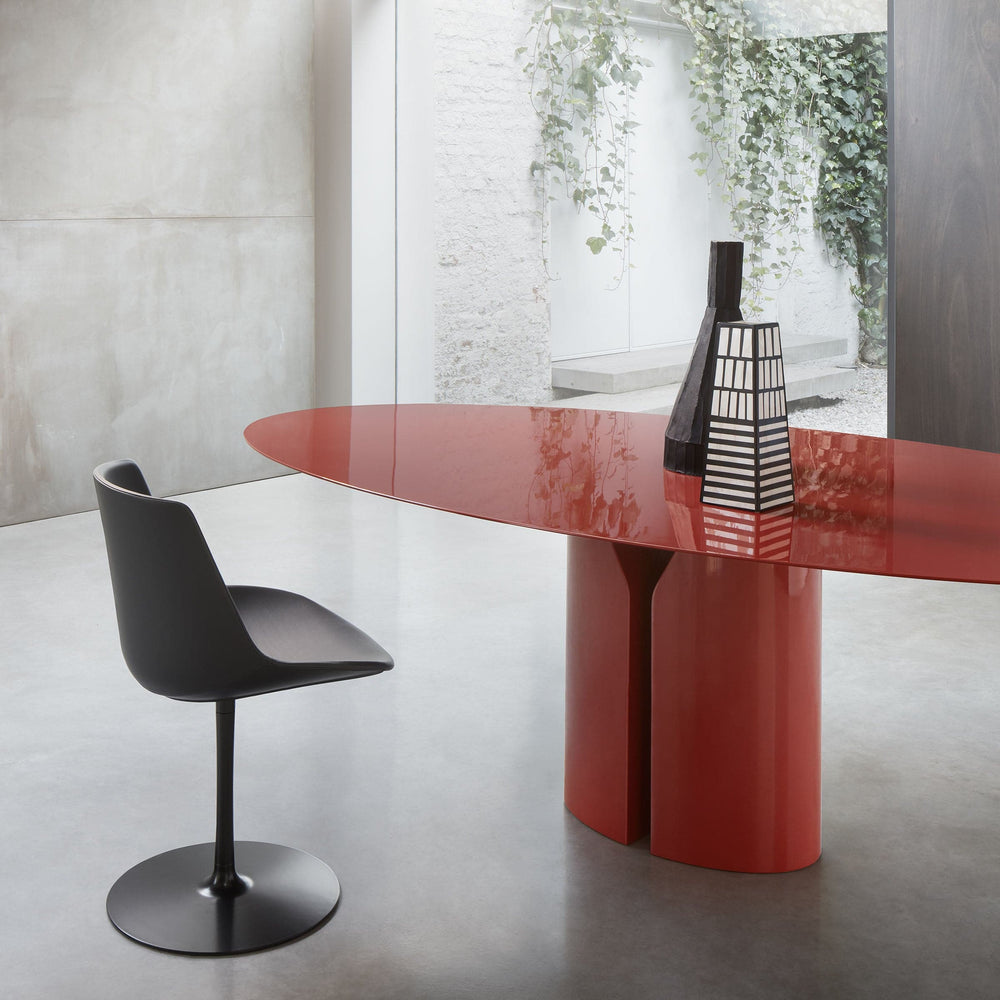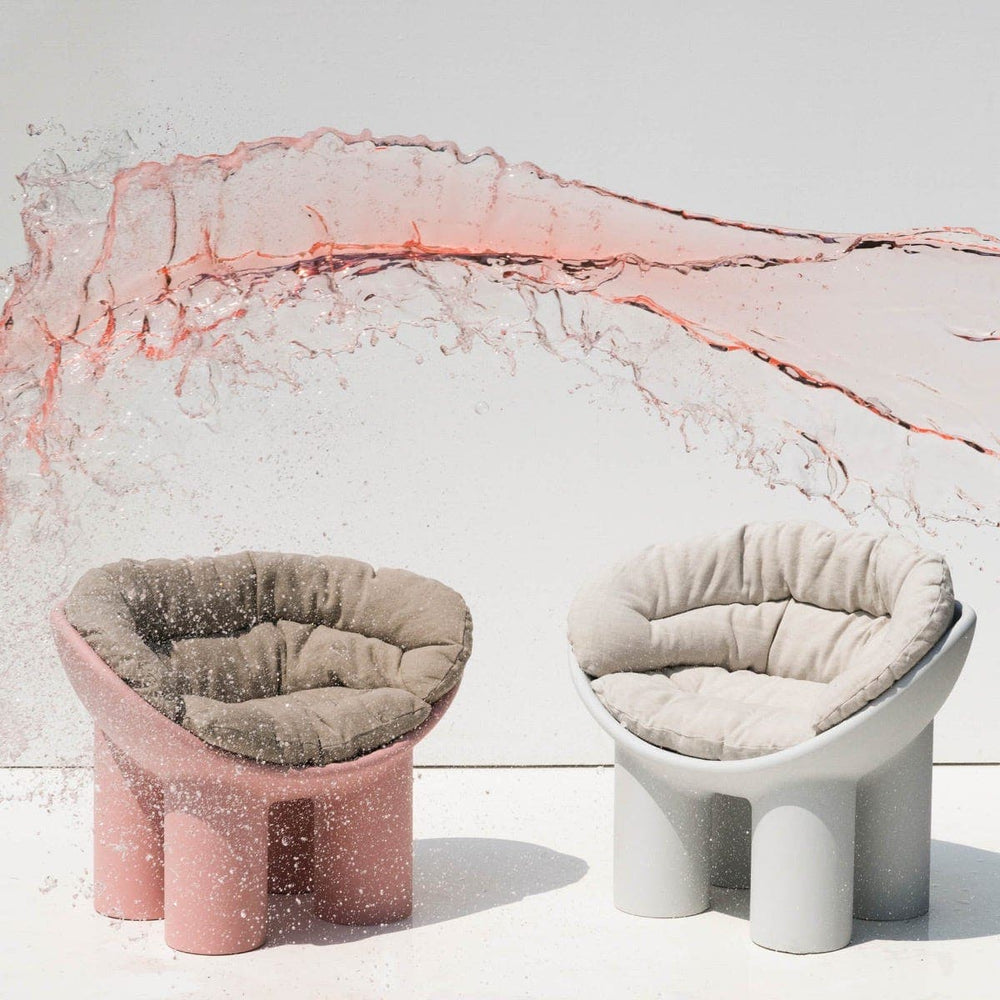HOW ORGANIZE YOUR HOME WORKPLACE TO WORK SMARTER, NOT HARDER
The List #14
by Antonella Dedini
This month’s The List is dedicated to all things remote working and work-life balance.

Pictured:
Gemma Correll; Work Smarter, Not Harder illustration; March 2022
WORK SMARTER
Can you work from home and be productive? When working from home burst onto the scene in 2020, it destabilized our private lives to a certain degree. At least until we seized the opportunity to use remote working to improve the quality of both our personal and professional lives.
And by now, we’re all well aware that there are certain key points that we have to keep in mind when working from home or remotely:
1 - We have to separate work time and play time, and respect both of them.
2 - We have to listen to our bodies when we’re hungry, tired, or need to take a break.
3 - The perfect remote working space has to be stylish, comfortable, organized and private.
4 - Working remotely doesn’t mean isolating ourselves from our colleagues.
5 - There’s a tool for everything: we have to make sure we have everything at our fingertips.
While these might seem trivial, they can make remote and home working all the more a positive experience for the mind and body. Read on for a list of products and accessories that will make your remote working experience all the smoother.
TIME MANAGEMENT
Hourglass lamp by Nicola Azzaro
Self-discipline and proper time management are fundamental when working remotely. Over the past couple of years, all of us have experienced the frustration of losing track of time and consequently not being able to finish our work.
Here are some basic rules to live by when working outside the office:
1 - Keep everything tidy around you and make to-do lists.
2 - Assign your tasks a level of priority from most to least urgent.
3 - Set a start and end time for your day and try to stick to it.
An hourglass is the perfect metaphor for this type of day-to-day self-discipline.
Fun fact: an hourglass was once called a “clepsydra” or sand or water clock, and the origins of the hourglass date back to the ancient Egyptians as early as the 15th century BC.
An hourglass fundamentally consists of a receptacle that gradually empties to fill another similarly shaped receptacle below it. Time is calculated according to how long it takes the sand or liquid to empty out. An hourglass is used to measure short intervals of time and isn’t precise, but it was the first tool to measure time, along with observing the sky and its celestial bodies.
The lamp pictured was designed by Nicola Azzaro and it resembles a beautiful lamp, reminiscent of the fact that in ancient times, sundials were used during the day and hourglasses at night.
WATCHING TIME GO BY WITH A PERPETUAL CALENDAR
Timor perpetual calendar by Enzo Mari for Danese Milano (1966)
Timor is a famous and iconic perpetual desk calendar and was the result of rational design carefully focused on the object’s function and the naturalness and intuitiveness of the movements required to update the day, month and year.
The PVC cards fan out and are attached to a central base, making it impossible to lose them. The name is that of an Indonesian island since Bruno Danese, the founder of the manufacturing company, initially decided to name his products after the exotic islands he loved most.
The calendar has easy-to-read lettering in Helvetica font and that’s reminiscent of 1940s railroad signage. The decision to produce this object in ABS plastic and not in other materials like iron or aluminum stems from making it lighter, easy to assemble, and inexpensive, which were fundamental for Enzo Mari. The calendar has never gone out of production since, and it’s a part of MoMA’s permanent collection.
In the words of Enzo Mari: “Perpetual calendars always present some substantial difficulties: one must remember to update them every day, and they require interaction”. It’s precisely this interaction that makes the ritual recording of the passage of time so sacred.
PERPETUAL CALENDAR FORMOSA: A DAILY GESTURE
Formosa perpetual wall calendar by Enzo Mari for Danese Milano (1963)
Formosa is one of the most famous perpetual wall calendars and is part of MoMA’s permanent collection.
It has a rational, minimalist, and still very contemporary style, and makes an impact with its shape, proportions, and the use of Helvetica font.
Formosa consists of an anodized aluminum base which supports the PCV sheets containing the numbers of the days, the days of the week, and the months. It’s divided into four parts to indicate the date of the month and the day of the week.
Changing the days, months and years becomes a fun daily ritual with Formosa, similar to the joy of Christmas advent calendars.
ORGANIZING YOUR HOME OFFICE SPACE
Wonder Valley cabin interior, realized by Andrea Zittel (2016)
It’s important to pick out a space that can become your office at home. And if you don’t have a specific room, take it as an opportunity to rearrange the things to create a little corner that you can dedicate to you and your work.

Californian artist Andrea Zittel is one of the most fascinating and sophisticated figures in contemporary art today. As usual, I like to mention art and its powerful expressiveness to describe concepts.
In her work, Zittel speaks of a “tailor-made” world made up of everyday gestures, like working from home, that are part of having a better life. In a 2010 interview with the Living section of Italian newspaper Corriere della Sera, she stated: “Sometimes, if you can’t change a situation, you just have to change the way you think about it”.

Here, Zittel sought out the most appropriate materials, proportions and compositions of spatial modules, the concept of comfort, minimalist furniture and ergonomic principles, changing up the spaces and objects that are part of an individual’s life. Her work is more pertinent today than ever before.

PRACTICAL WALL DESKS
Sfoglia floating shelf and desk, realized by Bellavista & Piccini for Mogg
Easy to set up and use, floating desks or wall desks are ideal pieces of furniture for working from home, especially for those who live in smaller homes.
Sfoglia is a perfect example of this. A slim metal shelf that hangs elegantly and subtly from the wall, it comes in a variety of finishes. It almost seems to flip off the wall like the page of a book, serving as an extremely simple accessory but also a sophisticated and functional piece of furniture. You can also hang Sfoglia upside-down to create different arrangements of shelving and desk space for working and studying.
A HIDDEN DESK: THE PERFECT WORKSPACE
Labor Ecru desk, realized by Luciana Gomez for Myin

Labor is a beautiful desk that features a smooth and elegant exterior with a clean, minimalist design while an explosion of pattern and color awaits inside. A convenient flap door can be closed to hide papers, books and computers, creating an instant sense of order.
Luciana Gomez is one of the young designers who have decided to focus on empathetic design, which puts individuals at the center of design projects and creates pieces that adapt to the needs of the people who use them.
This desk by Gomez is a perfect example of how – like with people – it’s often more gratifying to slowly discover what’s inside.
REAL OR VIRTUAL SPACE? THE METAVERSE IS MIXED REALITY
Image taken from the Microsoft MESH program demo; two images by Daniele De Angelis for the thesis Design in the Metaverse; 2022; NABA Milan
What exactly is the Metaverse, and how can it support remote working?

The Metaverse can be defined as an infrastructure consisting of multiple interconnected virtual worlds that can be accessed through a common platform that incorporates 2D and 3D elements in an immersive way. This is the new experience offered by “mixed reality”, or the result of combining the physical and digital worlds.

It’s an evolution of the real world, but in an enhanced way thanks to elements that are not physically present but can be interacted with through sensors and special devices, including smartphones, tablets and smart glasses. Mixed reality can be considered an enhanced version of augmented reality (source: www.dgroove.it).

For those interested in learning more, Microsoft’s new Mesh software, for example, will take the virtual reality experience to a whole new level to get ready for the Metaverse.
Since remote working has hit the ground running, more and more companies are experimenting with the Metaverse as a real workplace. The Metaverse is becoming the best alternative to face-to-face relationships, and is poised to become an office space that will give interior designers a lot of work in the future. This while keeping in mind that traditional design criteria will have to explore alternatives in terms of space and social relationships, with collaborative meetings in mixed reality, all from home or other remote locations.
BOOKCASES: THE ULTIMATE WAY TO KEEP A HOUSE TIDY
Mac Gee bookcase designed by Philippe Starck for Baleri Italia (1984)
Having a neat, organized space is a must when working from home.
The Mac Gee bookcase was one of Philippe Starck’s first projects at the beginning of his career. A fortuitous encounter with visionary entrepreneur designer Enrico Baleri gave Starck the opportunity to enter the world of Italian design head-on. Baleri was a pro when it came to manufacturing, and thanks to his indispensable values – including authenticity, consistency, discretion, lightness, evolution, ecology, irony, internationality and non-obsolescence – he created extraordinary designs that are displayed in museums all over the world.

This bookcase is one of these beautiful designs and is an absolute classic. Modular and with a central upright section that is anchored to the wall, it accommodates five shelves with decreasing depths and that resemble an airplane wing.
Bravo Starck, and bravo Baleri.
CREATIVE BOOK DISPLAYS
Sapiens bookcase, designed by Bruno Rainaldi for BBB Italia
Some of us bookworms have far too many books in the house. I personally have hundreds of them, including ones on the floor and ones that are used as nightstands or side tables. Space is getting tighter, and often it’s hard to find a specific book when I’m looking for it.
And yet, there are those people who are capable of impeccably organizing their books, whether in alphabetical order or based on author or topic. There are also those who prefer to display their books horizontally, which also makes for easier consultation.
Fashion designer and photographer Karl Lagerfeld boasted an immense collection of over 300,000 books in his Paris apartment, and all of them lay in a horizontal position. He hung up thin steel shelves placed at a lower height than a normal bookcase to make it easier to pull books off the shelf.
This is why Rainaldi's Sapiens bookcase is so innovative. With small shelves that shoot off a central supporting structure, it comes in multiple heights and is perfect for any space.
In addition to being designed for displaying books horizontally, it’s easy to move around and position anywhere in a room, making your favorite books always just a reach away.
A BOOKCASE WITHIN A BOOKCASE
Bookshape small green plexiglass bookshelf: a limited edition by Lettera G

When you look at books on a shelf, do you see order or chaos? Our objects speak to us, demanding our attention by claiming their proper space in our lives.
The things and objects that surround us are a reflection of who we are, including books, Like photos, old books with their crumpled and written-on pages with scents, dedications, anonymous statements, clippings and unmentionable secrets, demand our respect.
Finding the right spaces for our books isn’t always easy. We might tell ourselves that one day, we’ll catalog our entire collection. In the meantime, a form of deep respect for ourselves and for our books is to try to place them in the right, unique space in a special bookcase.

CHOOSING COMFORT WHEN WORKING OR PLAYING
Aleaf Chair designed by Michele Franzina for BBB Italia
When working it’s essential to seek out a space where we can sit comfortably without creating back pain for ourselves while bending over our computers.
Whether remote working or watching television, there are some truly intelligent seating options on the market today.
Working or playing remotely doesn’t mean making do with just any old tabletop or sitting for hours on end on chairs that weren’t designed for the purpose, with all the risks that this entails for our posture.
It means having a professional workstation not only in the office but also at home. And if you find a chair that also includes a desktop, like Michele Franzina’s Aleaf Chair, all the better!
KEEP TAKING THOSE COFFEE BREAKS
Mediterraneo black stoneware coffee set, designed by Laudani & Romanelli for Driade

We all have patterns and habits throughout the workday that make it go faster or see us through to the end of the day. And it’s important to keep up with those habits and traditions even when working from home.

If you’re used to having a steaming cup of coffee or an espresso before getting to work or on your morning break, treat yourself and keep on doing so even on those days you don’t work from the office.
Choosing the right cup for your coffee is also importnat. Did you know that a cup with a thick rim is best for coffee? And don’t choose a cup or mug with a random shape: its shape should be designed to enhance the taste, aroma and appearance of your coffee. For example, espresso is best savored in a tapered coffee cup.
ROOM DIVIDERS AND PRIVACY
Cartoons room divider designed by Luigi Baroli for Baleri Italia (1992)
This beautiful room divider stands in the harmonious shape of a sinuous “S”.
Made of completely recyclable pure cellulose, this design was ahead of its time in terms of environmental awareness, and its designer recognized the importance of preserving the environment and recognizing its value. It’s also light to move and easy to close, and takes up very little space as it rolls up.

The Cartoons room divider can be designed with scenes depicting Guido Crepax’s Valentina character, as ten different images were selected from the Crepax Archive to use on the front and back of this timeless room divider.
SWING ROOM DIVIDER: NOW YOU SEE ME, NOW YOU DON’T
Swing room divider, designed by Alessandro Di Prisco for Mogg
Our increased need over the past couple of years to create separate spaces in our homes has brought room dividers back into vogue. Alessandro Di Prisco’s Swing room divider features a beautifully simple design, with its circular form anchored to a cylindrical base that makes it appear almost sculptural.
The 90-degree rotation of the structure creates a dance in space, allowing it to separate one area of the house from another.
SMALL AND FUNCTIONAL DESK ACCESSORIES
Canarie desk set, designed by Bruno Munari for Danese Milano (1958)
This elegant desk set includes a pen holder, a clip holder, and two separate storage sections, all to help keep your desk space tidy.
Compact and versatile, you can customize this set to best fit your needs.
STATIONARY TOOLS: THERE’S A TOOL FOR EVERYTHING
Illustration from Encyclopedia, or a Systematic Dictionary of the Sciences, Arts, and Crafts by Denis Diderot and Jean Baptiste Le Rond D'Alembert; 1751–1752;
Neri mechanical pencil, by Giulio Iacchetti for Internoitaliano

Denis Diderot’s Encyclopédie was an inventory of all writing tools and consisted of 11 volumes illustrated with 2000 pictures. It shows how to arrange a perfectly organized workspace or desk. Calligraphy was at the time considered an art with its own specific rules, and was taught as such.
Moreover, the inclusion of an entire section devoted to writing in the Encyclopédie was indicative of the desire typical of the Enlightenment to spread culture through literacy.
3D PRINTED MECHANICAL PENCIL
Steel mechanical pencil Matitona, designed by Denis Santachiara for Cyrcus Design
Like many people over the past couple of years, it’s likely that you’ve had to acquire the skill of adaptation. For instance, going from a fully equipped workspace and office to working from home with limited resources may have come as a shock for many.

But who knows, perhaps in the future we’ll be able to 3D print work accessories right from the comfort of our own homes. And as Denis Santachiara writes in his book Download Design, “What happens if the means of production become accessible from a smartphone? What if even only some goods don’t need to be created in factories because they’re made or produced locally and managed online directly by the designer and the consumer? It’s easy to understand what the revolutionary scope of this would be...What about the design system? Is it ready to be 2/3/4.0? What if everyone were potentially a designer, producer and consumer in an unprecedented tautological and contextually global circle?"





































